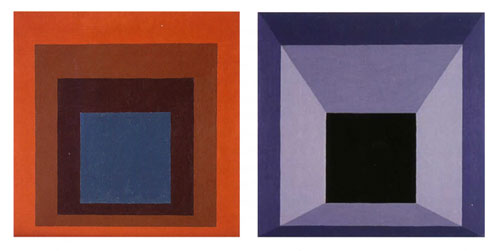|
Joseph Albers, Study for an Homage to the Square, National Gallery of Australia, Canberra, 1956 |
 |
Joseph Albers, Homage to the Square, San Francisco Museum of Modern Art, 1962 |
"Almost as soon as I arrived there. I got involved with two really big forces — Albers, who was very dynamic, and Abstract Expressionism at the New York galleries. At that time, it was really exciting to be in New York. I saw paintings by Stuart Davis. for example, one of the first Americans to use strong color, and he fascinated me. I'd keep going to see his works at the Downtown Gallery. I was able to see originals by Shahn and Kuniyoshi for the first time, too. I also got very interested in Cezanne and the Impressionists, and Bonnard and Matisse. Being able to go to the Museum of Modern Art regularly was a terrific advantage. When l saw works by Paul Klee there, some ideas of my own began to make more sense."11
Albers was a formidable teacher, never straying from the principles he had absorbed and then taught at the Bauhaus in the 1920s and 30s. He avoided personal friendships with his students, convinced that they learned best, "figuring things out for themselves."12 Even so, the young artists were constantly assigned exercises in the relationships of forms and colors.13 Anuszkiewicz recalls, "he could look at a painting for what it was and in a very abstract manner he could just show in your work what wasn't happening and what was happening. Albers was not somebody that would cuddle you or baby you or even befriend you. He would really lay it on the line."14
Albers had recently begun his series. Homage to the Square. Choosing the simplest form he knew. squares within squares, he set out to demonstrate that colors vary according to their environment. He said, "I see colour as motion... To put two colours together side by side really excites me. They breathe together. It's like a pulse beat... l like to take a very weak colour and make it rich and beautiful or work on its neighbours. l can kill the most brilliant red by putting it with violet. I can make the dullest grey in the world dance by setting it against black."15 Albers did not mix colors, putting them on right out of the tube.
Years later, when Anuszkiewicz was asked about these classes, he said, "Albers used to talk about Cezanne, he used to talk about Klee. and that helped in appreciating the work. For the first time I started appreciating what the Impressionists were doing and l could then appreciate his color ideas — something does happen when you put two colors together, it has an effect.
